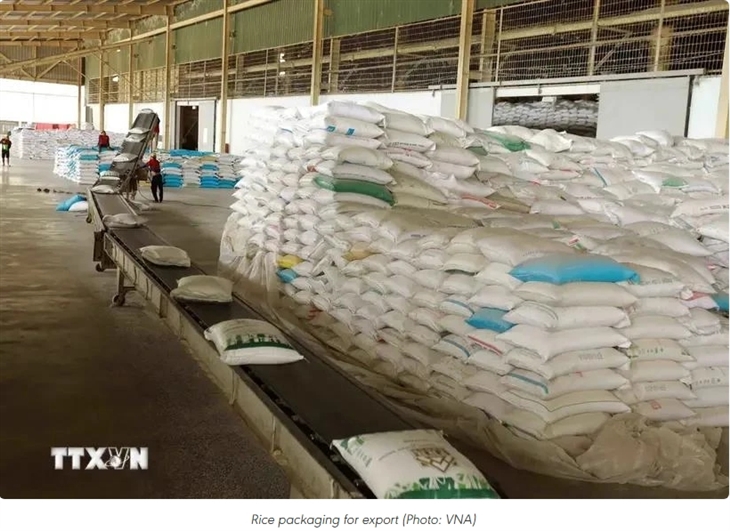Vietnam aims to increase market share in Africa
Tuesday, November 12,2024
AsemconnectVietnam - Although Vietnam’s rice exports have traditionally focused on Asian markets, experts have advised businesses to pay more attention to Africa which has emerged as a key potential market.
Although Vietnam’s rice exports have traditionally focused on Asian markets, experts have advised businesses to pay more attention to Africa which has emerged as a key potential market.
A promising market
According to the Asia-Africa Market Department under the Ministry of Industry and Trade (MoIT), Africa is an important export market for Vietnam's rice. The export of this grain to Africa rose to 692.6 million USD in 2021 from 411 million USD in 2017. Rice typically accounts for 15-20% of Vietnam’s total exports to Africa.
However, in 2022, Vietnam’s rice exports to Africa declined by 10.5% compared to 2021, reaching only 620 million USD, equivalent to 16% of Vietnam’s total exports to this continent. This drop was largely due to increased global food stockpiling amid economic and political instability, which pushed up rice prices and led some African countries to reduce the import of the food. Furthermore, the COVID-19 pandemic caused significant disruptions in global rice supply chains, with exporting countries cutting back on exports to secure domestic food supplies.
In 2023, however, Vietnam’s rice exports to Africa bounced back, reaching 1.3 million tonnes valued at 788 million USD, up 6.3% in volume and 27.7% in value compared to 2022.
Over the years, several African countries have ramped up domestic rice production in an effort to increase reserves and meet local demand. However, this remains challenging due to financial and technical issues in rice cultivation. As the population grows, along with the influx of Asian tourists and workers, demand for rice in Africa continues to rise.
For these reasons, Africa remains a market with significant potential for Vietnam’s rice exports in the coming years.
Countries like Ivory Coast, Ghana, Senegal, and Cameroon are major importers of Vietnamese rice. Ivory Coast, in particular, has continued to be a key market for Vietnamese rice in the region. Currently, Vietnamese rice is mostly exported to Africa through major international trading companies such as Louis Dreyfus, Olam, Phoenix, Platinum, Wilmar, WSGF Group, and Stallion Group.
Shifting from regular to fragrant rice
Historically, Vietnam’s export of the grain to Africa were primarily white rice, with 15% and 25% broken rice being the main types. However, in recent years, Vietnam’s market share in Africa has faced stiff competition from Thailand, India, and Pakistan, who benefit from large stocks of cheap white rice, which is more affordable for many consumers in Africa.
Alongside the demand for cheaper rice, there has been an increasing interest in fragrant rice in Africa, driven by urbanisation and rising incomes in cities. Nguyen Chi Mai, Vietnam’s Trade Counsellor in Nigeria, who also covers several other African nations, including Ghana, noted that urban consumers in Ghana prefer imported rice, especially fragrant rice, to local varieties. As a result, 80% of the country’s rice imports are consumed in urban areas. Restaurants in Ghana often use fragrant rice to attract customers. The country imports fragrant rice mainly from Vietnam, the US, and Canada.
Given this trend, African importers have increasingly sought to purchase Vietnamese fragrant rice due to its consistent quality and competitive pricing. Do Ha Nam, Vice President of the Vietnam Food Association, noted that exports of fragrant rice to Africa have grown steadily in recent years.
The Asia-Africa Market Department has identified fragrant rice as one of the fastest-growing varieties in terms of export growth to Africa. As such, increasing exports of fragrant rice presents a key strategy for boosting both the value and market share of Vietnamese rice on the continent.
Drastic measures needed
To further promote rice exports to Africa, the Ministry of Industry and Trade suggests that Vietnamese government agencies continue to refine export mechanisms and management of rice trade to accommodate market developments. It is also important to create favourable conditions for businesses to engage in rice exports and deepen their involvement in the global rice value chain.
Leveraging existing bilateral cooperation frameworks, such as joint committees and trade subcommittees between Vietnam and African countries, can help foster stronger rice trade relations, experts held. There is also potential to negotiate or extend memoranda of understanding on rice trade with countries in need of imports for stockpiling or those that have not fully liberalised their rice markets such as Uganda. Monitoring and supporting businesses involved in existing MOUs with Egypt, Comoros, Madagascar, Guinea, and Sierra Leone is also crucial, they added.
Experts also highlighted the need for improving transparency in the rice market, designing support policies in payments and logistics, promoting Vietnamese rice through trade programmes in Africa, and improving post-harvest technologies and workforce training, thus building long-term trust with African consumers and ensuring sustainable growth in this important market./.
Source: en.vietnamplus.vn/vietnam-aims-to-increase-market-share-in-africa-post303859.vnp
A promising market
According to the Asia-Africa Market Department under the Ministry of Industry and Trade (MoIT), Africa is an important export market for Vietnam's rice. The export of this grain to Africa rose to 692.6 million USD in 2021 from 411 million USD in 2017. Rice typically accounts for 15-20% of Vietnam’s total exports to Africa.
However, in 2022, Vietnam’s rice exports to Africa declined by 10.5% compared to 2021, reaching only 620 million USD, equivalent to 16% of Vietnam’s total exports to this continent. This drop was largely due to increased global food stockpiling amid economic and political instability, which pushed up rice prices and led some African countries to reduce the import of the food. Furthermore, the COVID-19 pandemic caused significant disruptions in global rice supply chains, with exporting countries cutting back on exports to secure domestic food supplies.
In 2023, however, Vietnam’s rice exports to Africa bounced back, reaching 1.3 million tonnes valued at 788 million USD, up 6.3% in volume and 27.7% in value compared to 2022.
Over the years, several African countries have ramped up domestic rice production in an effort to increase reserves and meet local demand. However, this remains challenging due to financial and technical issues in rice cultivation. As the population grows, along with the influx of Asian tourists and workers, demand for rice in Africa continues to rise.
For these reasons, Africa remains a market with significant potential for Vietnam’s rice exports in the coming years.
Countries like Ivory Coast, Ghana, Senegal, and Cameroon are major importers of Vietnamese rice. Ivory Coast, in particular, has continued to be a key market for Vietnamese rice in the region. Currently, Vietnamese rice is mostly exported to Africa through major international trading companies such as Louis Dreyfus, Olam, Phoenix, Platinum, Wilmar, WSGF Group, and Stallion Group.
Shifting from regular to fragrant rice
Historically, Vietnam’s export of the grain to Africa were primarily white rice, with 15% and 25% broken rice being the main types. However, in recent years, Vietnam’s market share in Africa has faced stiff competition from Thailand, India, and Pakistan, who benefit from large stocks of cheap white rice, which is more affordable for many consumers in Africa.
Alongside the demand for cheaper rice, there has been an increasing interest in fragrant rice in Africa, driven by urbanisation and rising incomes in cities. Nguyen Chi Mai, Vietnam’s Trade Counsellor in Nigeria, who also covers several other African nations, including Ghana, noted that urban consumers in Ghana prefer imported rice, especially fragrant rice, to local varieties. As a result, 80% of the country’s rice imports are consumed in urban areas. Restaurants in Ghana often use fragrant rice to attract customers. The country imports fragrant rice mainly from Vietnam, the US, and Canada.
Given this trend, African importers have increasingly sought to purchase Vietnamese fragrant rice due to its consistent quality and competitive pricing. Do Ha Nam, Vice President of the Vietnam Food Association, noted that exports of fragrant rice to Africa have grown steadily in recent years.
The Asia-Africa Market Department has identified fragrant rice as one of the fastest-growing varieties in terms of export growth to Africa. As such, increasing exports of fragrant rice presents a key strategy for boosting both the value and market share of Vietnamese rice on the continent.
Drastic measures needed
To further promote rice exports to Africa, the Ministry of Industry and Trade suggests that Vietnamese government agencies continue to refine export mechanisms and management of rice trade to accommodate market developments. It is also important to create favourable conditions for businesses to engage in rice exports and deepen their involvement in the global rice value chain.
Leveraging existing bilateral cooperation frameworks, such as joint committees and trade subcommittees between Vietnam and African countries, can help foster stronger rice trade relations, experts held. There is also potential to negotiate or extend memoranda of understanding on rice trade with countries in need of imports for stockpiling or those that have not fully liberalised their rice markets such as Uganda. Monitoring and supporting businesses involved in existing MOUs with Egypt, Comoros, Madagascar, Guinea, and Sierra Leone is also crucial, they added.
Experts also highlighted the need for improving transparency in the rice market, designing support policies in payments and logistics, promoting Vietnamese rice through trade programmes in Africa, and improving post-harvest technologies and workforce training, thus building long-term trust with African consumers and ensuring sustainable growth in this important market./.
Source: en.vietnamplus.vn/vietnam-aims-to-increase-market-share-in-africa-post303859.vnp
Workshop seeks ways to elevate Vietnam to global semiconductor supply chain
PM calls on Chinese aviation, agriculture firms to strengthen ties with Vietnamese partners
Vietnam’s WTO journey: From economic integration to global trade powerhouse
Numerous US businesses set to arrive in HCM City to implement signed agreements
Vietnam, Canada enhance cooperation, connections
PM pushes for stronger Vietnam-UAE economic ties at business roundtable
PM receives heads of UAE corporations
PM meets with leader of Russia's Rosatom
Hanoi seeks to tighten trade, investment links with RoK
US initiates administrative review on Vietnam’s oil country tubular goods
Peru’s mega-port to open opportunities for Vietnam's import-export, logistics
Crude oil importing to Vietnam increase sharply
Senegal considered as potential market for Vietnamese agricultural products
Experts optimistic about Vietnam-Australia relationship future

Plan of Hai Duong province for a period of 2021 - 2030, ...
Organize space reasonably and harmoniously, focusing on connecting Hai Duong in common development space, actively contributing to the ...Plan of Hau Giang province in a period of 2021 - 2030, ...
Sustainable forestry development program in a period of ...

Women’s seven-a-side football tournament to make national ...
Women’s seven-a-side football tournament to make national debut Vietnam will for the first time have an official seven-a-side football ...Vietnam advance to semifinals of ASEAN Futsal Championship
Vietnam int’l fashion week Fall/Winter 2024 to open



